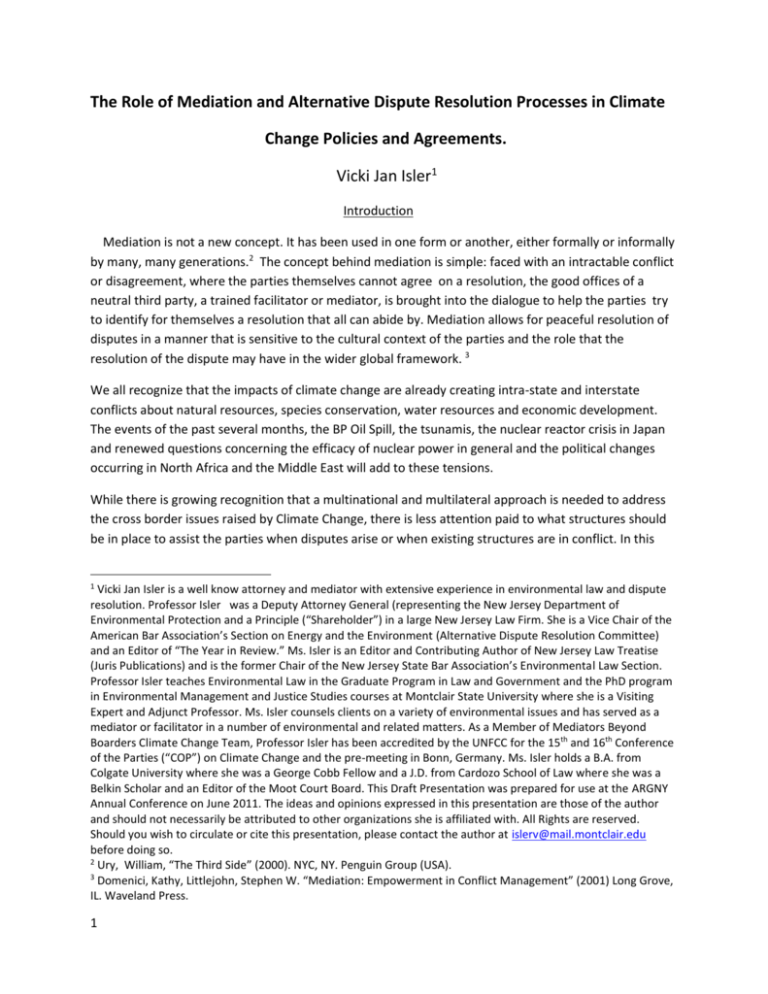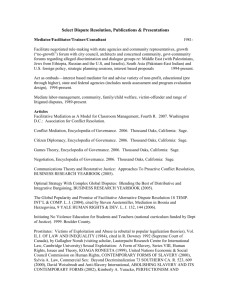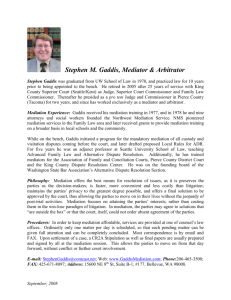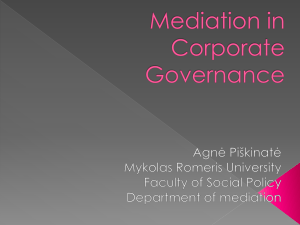
The Role of Mediation and Alternative Dispute Resolution Processes in Climate
Change Policies and Agreements.
Vicki Jan Isler1
Introduction
Mediation is not a new concept. It has been used in one form or another, either formally or informally
by many, many generations.2 The concept behind mediation is simple: faced with an intractable conflict
or disagreement, where the parties themselves cannot agree on a resolution, the good offices of a
neutral third party, a trained facilitator or mediator, is brought into the dialogue to help the parties try
to identify for themselves a resolution that all can abide by. Mediation allows for peaceful resolution of
disputes in a manner that is sensitive to the cultural context of the parties and the role that the
resolution of the dispute may have in the wider global framework. 3
We all recognize that the impacts of climate change are already creating intra-state and interstate
conflicts about natural resources, species conservation, water resources and economic development.
The events of the past several months, the BP Oil Spill, the tsunamis, the nuclear reactor crisis in Japan
and renewed questions concerning the efficacy of nuclear power in general and the political changes
occurring in North Africa and the Middle East will add to these tensions.
While there is growing recognition that a multinational and multilateral approach is needed to address
the cross border issues raised by Climate Change, there is less attention paid to what structures should
be in place to assist the parties when disputes arise or when existing structures are in conflict. In this
1
Vicki Jan Isler is a well know attorney and mediator with extensive experience in environmental law and dispute
resolution. Professor Isler was a Deputy Attorney General (representing the New Jersey Department of
Environmental Protection and a Principle (“Shareholder”) in a large New Jersey Law Firm. She is a Vice Chair of the
American Bar Association’s Section on Energy and the Environment (Alternative Dispute Resolution Committee)
and an Editor of “The Year in Review.” Ms. Isler is an Editor and Contributing Author of New Jersey Law Treatise
(Juris Publications) and is the former Chair of the New Jersey State Bar Association’s Environmental Law Section.
Professor Isler teaches Environmental Law in the Graduate Program in Law and Government and the PhD program
in Environmental Management and Justice Studies courses at Montclair State University where she is a Visiting
Expert and Adjunct Professor. Ms. Isler counsels clients on a variety of environmental issues and has served as a
mediator or facilitator in a number of environmental and related matters. As a Member of Mediators Beyond
Boarders Climate Change Team, Professor Isler has been accredited by the UNFCC for the 15th and 16th Conference
of the Parties (“COP”) on Climate Change and the pre-meeting in Bonn, Germany. Ms. Isler holds a B.A. from
Colgate University where she was a George Cobb Fellow and a J.D. from Cardozo School of Law where she was a
Belkin Scholar and an Editor of the Moot Court Board. This Draft Presentation was prepared for use at the ARGNY
Annual Conference on June 2011. The ideas and opinions expressed in this presentation are those of the author
and should not necessarily be attributed to other organizations she is affiliated with. All Rights are reserved.
Should you wish to circulate or cite this presentation, please contact the author at islerv@mail.montclair.edu
before doing so.
2
Ury, William, “The Third Side” (2000). NYC, NY. Penguin Group (USA).
3
Domenici, Kathy, Littlejohn, Stephen W. “Mediation: Empowerment in Conflict Management” (2001) Long Grove,
IL. Waveland Press.
1
presentation, I will highlight areas where mediation has already been used and outline why
consideration of a mediation provision in multilateral agreements such as the Cancun Agreements 4 as
they are revisited at the 17th Conference of the Parties (COP 17) in Durban, South Africa are needed. I
will also discuss lessons learned from the Conference of the Parties on Climate Change in Denmark (‘COP
15”) and Cancun (“COP 16) as they relate to dispute resolution.
Mediation Should Be One of the Tools in Our Tool Box to Address Conflicts Arising From Climate Change
A. Success Stories
While mediation is not a new concept, its use in Environmental Disputes is a little more recent. For
example, when conflict over the shared border and related control over natural resources between
Ecuador and Peru broke out in 1995, a series of discussions, interventions and negotiations, with third
party help from facilitators and mediators from Argentina, Brazil and the United States led to the signing
of the Acta de Brasilia, an act designed to reduce tensions and protect biodiversity between the two
countries. This act led to Ecuador’s creation of the Cordillera del Cóndor Park and Peru’s creation of an
Ecological Protection Zone and the Santiago-Comaina Reserve Zone. These “peace parks” have helped
promote diplomacy across borders, benefited the local communities and the countries involved and
have served as a potential model for other countries by turning trans-boundary disputes over territory
and natural resources into trans-boundary conservation zones.5
Mediation was also successfully used in the Amur Rivera dispute between China and Russia. The process
worked so well that it was employed again by the parties in a dispute over the Argun River.6 The World
Bank successfully employed mediation in a conflict between India and Pakistan that resulted in the 1960
Indus Waters Treaty governing water rights in the Indus River7 and the World Trade Organization
(“WTO”) has used its multi-step dispute resolution system, starting with mediation “to protect the
environment when certain conditions are met.” 8These are but a few of the examples where mediation
has been used.
B. Applicability to Climate Change Disputes
We usually think of the rule of law and the court systems, either interstate or internationally when
disputes between countries arise. The United Nations and International Organizations such as the World
Trade Organization may also come to mind, depending on the dispute. Each of these organizations has
their own set of Frameworks, treaties, protocols and other guiding principles that should be followed.
Indeed, one reason these international frameworks and protocols are developed is, in part, to reduce
4
FCCC/CP/2010/7/Add.1, FCCC/KP/CMP/2010/12/Add.1, and FCCC/KP/CMP/2010/12/Add.1 were adopted by
the various negotiating groups at the 16th Conference of the Parties (“COP 16”) in Cancun Mexico on December 1011, 2010; Copies of these agreements may be obtained as http://unfccc.int/2860.php.
5
Halle, Silija, ed. United Nations Environmental Programme. From Conflict to Peace building. 2009. P.25 as sited in
MBB Case Studies, Ibid.
6
Anna Spain, Rethinking International Dispute Resolution, Ibid, 25, 26.
7
Ibid.
8
Andrienne Lu “Environmental Groups Worry About Chrisite Agency Decisions” The Philadelphia Inquirer 10/13/10
p. B01.
2
and manage conflicts. However, these same frameworks and protocols may themselves “generate
conflicts when difficult policy choices that advantage some and disadvantage others “arise.9 This is when
a provision authorizing the use of mediation becomes most useful. “When setting priorities, distributing
resources, implementing and enforcing agreements that govern how people and nations work together,
conflicts will arise and warrant the development of procedures for effective resolution.”10 Directing
parties to mediation in anticipation of a dispute, or where unassisted negotiations are not working
allows for a timely, cost effective integrated approach to the dispute with the most potential for a timely
and sustainable resolution that is attentive to both the relational and the environmental aspects of the
dispute.11
Climate Change acts as a “threat multiplier which exacerbates existing trends, tensions and instability.”12
Environmental mediation tends to involve “multiple parties and complex technical and scientific issues,
necessitating more extensive up front assessment work, convening of the appropriate parties, mutual
learning and collaborative fact-finding, as well as agreement building and implementation planning.”13
Given both of these factors, the inclusion of the option of mediation in multilateral climate change
agreements could serve a useful function for all.
As recognized by the UN Security Council in Report # S/2009/189, provided to the Secretary-General:
“Since one of the most promising approaches to the peaceful settlement of disputes is skillful thirdparty mediation, we, the United Nations, have a responsibility to ‘We the people’ to professionalize our
efforts to resolve conflicts constructively rather than destructively and to save succeeding generations
from the scourge of war.”14 The report goes on to recommend the increased use of timely mediation
and the strengthening of capacity building at all levels of governments and civil society for constructive
resolution of disputes.15 This recommendation was echoed in the UNEP’s 2009 Report “From Conflict to
Capacity Building, the Role of Natural Resources and the Environment” stating that priority should be
9
Supporting Statement for the Inclusion of Mediation in Climate Change Negotiations, Mediators Beyond Borders
(“MBB”), UNFCC Climate Change Project. http://www.mediatorsbeyondborders.org/what/climatechange/statements/Supporting Statement for the Inclusion of Mediation in Climate Change Negotiations.
10
Ibid.
11
Cf: Tony Foley, ‘Environmental Conflict Resolution: Relational and Environmental Attentiveness As A Measure of
Success. 24 Conflict Resolution Quarterly 501 (2007).
12
EU Commission and High Representative 2008.Climate Change and International Security: Paper to the European
Council. S113/8. European Council. Brussels as cited in the UNEP Report, Ibid.
13
Jacob Bercovitch (ed.) 1996. ‘Resolving International Conflicts: The Theory and Practice of Mediation’. Boulder,
Colorado. Lynne Rienner Publishers and Rosemary O’Leary and Lisa Blomberg Bingham. (eds). 2003. The Promise
and Performance of Environmental Conflict Resolution. Washington DC, Resources for the Future. See also MBB
Supporting Statement, Infra.
14
Report to the Secretary-General on enhancing mediation and its support activities, United Nations Security
Council, Report # S/2009/189; MBB Supporting Statement, Ibid.
15
Ibid.
3
given to “capacity-building for dispute resolution, environmental governance and land administration in
states that are vulnerable to conflicts over resources and the environment.”16
Unlike conciliation under the UN convention, there is no need for delay in bringing parties to the
mediation. Researchers have confirmed that mediation is an effective tool in reaching high quality
agreements and building cooperative working relationships among parties.17 In an area where significant
changes in behavior and relationships will be needed to reduce our carbon footprint and co-operation
over the allocation of resources is a must, the availability of a mechanism to resolve conflicts in a timely
and potentially transformative way is essential. While this should not be the only mechanism, the
incorporation of this process in future Climate Change Agreements should be recognized as an option.
Where have the Mediation Clauses Gone?
While they have not been used frequently in negotiating international environmental conventions and
treaties, there is evidence of the successful use or inclusion of mediation in these types of situations. 18
For example, the Vienna Convention on the Protection of the Ozone Layer, Article 11 (1, 2) provides:
1. In the event of a dispute between Parties concerning the interpretation of this Convention, the
parties concerned shall seek solution by negotiation.
2. If the parties Concerned cannot reach agreement by negotiation, they may jointly seek the good
offices of, or request mediation by, a third party.
3. When ratifying, accepting, approving or acceding to this Convention, or at any time thereafter, a
State or regional economic integration may declare in writing to the Depository that for a
dispute not resolved in accordance with paragraph 1 or paragraph 2 above, it accepts on or both
of the following means of dispute settlement as compulsory:
a. Arbitration in accordance with procedures to be adopted by the Conference of the Parties at
its first ordinary meeting:
b. Submission of the dispute to the International Court of Justice. 19
The parties in the first instance have a mechanism available to them, a tool to try and resolve the
dispute in a peaceful way. The mediation can be initiated at anytime, often helping to avoid long
protracted destructive disputes. Mediators can also serve as a face saver, helping the parties to address
solutions that might be acceptable to a party but would be perceived as a weakness if it was initially
16
UNEP From Conflict to Peacebuilding: The Role of Natural Resources and the Environment. UNEP February 2009.
http://postconflict.unep.ch.pub;ications/pcmb policy 01.pdf. See also MBB Supporting Statement, Ibid.
17
U.S. Institute for Environmental Conflict Resolution, Morris K. Udall Foundation, 2009.
“Environmental Conflict Resolution: Performance Evidence from the Field” www.ecr.gov.; MBB Supporting
Statement, Ibid.
18
Deborah Schueli and Ariella Vranesky. 1996 “Environmental Mediation in International Relations” in Bercovitch.
Ibid.; For a good discussion of situations where mediation has been successfully employed in environmental
disputes, see MBB Case Studies, Ibid, See also Anna Spain “Beyond Adjudication: Resolving International Resource
disputes in an Era of Climate Change” 30 Stanford Environmental Law Journal ___(2011) (publication pending).
19
United Nations Environment Programme. Handbook for the Vienna Convention for the Protection of the Ozone
Layer, 2009, p. 8.
4
identified by a party themselves. 20 While the Mediator may help the parties identify and evaluate
options, it is the decisions of the parties themselves that are controlling.21 If these efforts fail, then the
auspices of the International Court of Justice or other formal bodies or procedures may attach, often
with the issues to be addressed having been narrowed through the use of the mediation process.
The UN Charter mandates that “[t]he parties to any dispute, the continuance of which is likely to
endanger the maintenance of international peace and security, shall, first of all, seek a solution by
negotiation, enquiry, mediation (emphasis added), conciliation, arbitration, judicial settlement, resort to
regional agencies of arrangements, or other peaceful means of their own choice.”22
Negotiations sponsored by the United Nations Environment Programee (“UNEP”), a quasi-autonomous
subsidiary of organ of the United Nations General Assembly led to the 1985 Vienna Convention on the
Protection of the Ozone Layer mentioned above and to its 1987 Montreal Protocol. These agreements
provided the UN Secretariat with the “treaty organs (e.g. the Meeting of the Parties) established by
either instrument; in the later capacity it assisted in the Helsinki, London and Copenhagen meetings at
which important amendments to the protocol were negotiated and adopted.”23 Yet, with these later
adoptions, a specific reference to mediation was not made.24
In 2008, the United Nations created a five-person Mediation Stand-by Support Team for deployment of
mediators to conflict areas “on short notice to lend expertise in areas including power sharing,
constitution formation, security, human rights and justice.”25 The focus of this team was not specifically
to assist parties to achieve agreement on how to address climate change or disputes arising there from,
but rather to help in a peace-building role once conflicts have erupted. However, there has been some
concern expressed about whether this is the best institution to provide mediation services. “The U.N.
lacks the human and financial capacity to meet demands for mediation services in international
conflicts. States often seek assistance from the U.N. for the most difficult cases and at the stage when
conflict is least capable of being resolved.”26 Inclusion of appropriate dispute resolution clauses that
recognize mediation as an option can allow the parties to request the assistance of the stand-by team if
it is appropriate and available or to look toward other available facilitators with the expertise to help the
parties resolve their dispute, thereby addressing these concerns. We should not ignore the magic of
20
Edith Weiss Brown; Stephen C. McCaffery, Daniel Barstow McGraw and Dan A. Tarlock, “International
Environmental Law and Policy” © 2007, Aspen Publishers, New York, NY, pps. 164-165.
21
Unlike formal adjudications, such as those conducted at the International Court of Justice, the discussion and
resolution need not be limited to the issues or parties identified in a specific treaty, but can, at the discretion of
the parties be expanded as appropriate to create sustainable, supportable and implementable resolutions. See
Anna Spain, Rethinking International Dispute Resolution, 32 U. Pa. J. Int’l L., 1,18, note 74 (2010).
22
Anna Spain, Rethinking International Dispute Resolution, 32 U. Pa. J. Int’l L. 1, 8 citing the U.N. Charter art. 33,
para. 1-2.
23
Id. P. 184.
24
The Helsinki Rules on the Uses of the Waters of International Rivers, Article XXXII does state that if a dispute is
considered by the States to be incapable of resolution in the manner set forth in article XXXXI (i.e. voluntary
negotiations between the parties) that the parties may jointly request the mediation of a third state, of a qualified
international organization or of a qualified person.
25
See Anna Spain, Rethinking International Dispute Resolution, Ibid, 25, 26.
26
See Ann Spain, Rethinking International Dispute Resolution.
5
mediation, but instead work to make sure that there is a mechanism available to ensure that multiple
meditation processes will be an option available to the parties and stakeholders, at a meaningful time
and in a meaningful way, when disputes triggered by climate change arise.
We are now facing a world economic crisis. Areas for discord are increasing. Movements toward
creating new forms of government are starting to take hold. In a high-level brief by the European Union
Commission, climate change was described as “posing security risks by acting as a threat multiplier
which exacerbates existing trends, tensions and instability.”27 One tool to address this threat could be
recognition of a role for mediation in climate change disputes. As noted in the UN’s April 09, 2009
Security Council Report to the Secretary-General, benefits of mediation include: 1) addressing the root
causes of conflict; 2) helping overcome obstacles that block progress through conventional means; 3)
taking economic, environmental and community interests and values into account; 4) being sensitive to
cultural differences and accommodating peace and justice concerns; and 5) creating sustainable
agreements that facilitate implementation.28 As the parties get ready for the 17th Conference of the
Parties (“COP 17”) the need for new tools for the climate change solution tool box has never been
greater.
What’s Next
In last week of November 2011 through the first week of December 2011 COP 17 will be held in Durban,
South Africa. The lessons learned from inflated expectations in Copenhagen (COP 15)29 and the modest
success achieved in Cancun (COP 16) set the stage for these negotiations. However, unlike the situation
faced at the last two meetings of the parties, nuclear energy, one of the key strategies relied upon by
many parties to Kyoto Protocol and subsumed in some of the underlying assumptions for the
Copenhagen Accord and the Cancun Agreements now raises new issues and requires a re-evaluation of
parties’ positions in light of the nuclear disaster in Japan. These unexpected consequences and the
fallout from them highlight the need for flexible dispute resolution mechanisms in future climate
change agreements.
The Cancun Agreement recognizes that the Kyoto Protocol (“KP”) will end in 2012 unless it is
reauthorized or extended. Discussions on the future of KP were postponed until COP 17.30 The events
in Japan will impact the nature of discussion concerning the KP’s future as well as many of the
assumptions made in the earlier agreements.
27
EU Commission and High Representative. 2008. Climate Change and International Security: Paper to the
European Council. S.113/8. European Council. Brussels as cited in the UNEP Report, Ibid. See also MBB Supporting
Statement, Ibid.
28
United Nations Security Council, April 2009. “Report of the Secretary-General on enhancing mediation and its
support activities”. S/2009/189/8; MBB Supporting Document, Ibid.
29
While commitment for Carbon Reduction that was ambitious and binding was called for, and the expectations
for this outcome were high, these inflated expectations and the resultant “Copenhagen Accord led to
disappointment and distrust that impacted the dialogue leading up to COP 16, and the meeting of the parties and
subsidiary groups at COP 16.
30
For a good discussion of the structure of the UNFCC Climate Change negotiating structures see: Spain, Anna.
“Beyond Adjudication: Resolving International Resource Disputes in an Era of Climate Change” 2011, 30 Stanford
Law Review ____.
6
The fragmented nature of International Treaties, Protocols and regulatory regimes makes consensus
on a broad package of agreements governing climate change essential. Since a treaty does not create an
obligation or a right to a third State without out its agreement, the fractured approach to International
Agreements and Treaties means that there is a patchwork of multi-party mechanisms under
international law that will impact or will be impacted by climate change in some way. The interaction
between existing laws and policies impacting climate change with new laws and mechanisms increases
the likelihood that disputes will occur. As we sew together a patchwork of mechanism to integrate the
past, present and future a mechanism for addressing what happens when these threads start to weaken
or unravel is needed. I submit that mediation can serve as one of the mechanism or tool that can
address these loose threads or threats.
Mediators Beyond Borders, a volunteer group of mediators from around the world, has been
advocating, on behalf of mediators around the globe for the inclusion of mediation as an option in multilateral climate change agreements. 31 At each of the Climate change meetings, members of the MBB
Climate Change Team, of which I am one, have discussed the use of mediation by mediators around the
world and the efficacy of its use in climate change disputes. Interest in learning about mediation by
delegates from the least developed countries and some of the more developed countries, as well as
Intergovernmental Agencies and Non Governmental Organizations has been high. As the roadmap to
address climate change becomes more complex, the need for additional means of guidance when
disagreements occur becomes greater. The greater transparency and revised expectations created
allowed for the 11th hour agreements in Cancun. With the evidence of the down side of failure to deal
with Climate Change Issues dramatically demonstrated by the events of the last year, the time has come
to expand the tools available to all parties to address the global concerns over climate change. I submit
that, for the reasons discussed above, mediation should be one of these tools.
31
MBB’s supporting Statement suggests:
“1. (A) Reaffirming the principles set forth in chapter VI, Articles 33-38 of the UN Charter governing the peaceful
settlement of disputes, the parties agree to any dispute resulting from the interpretation or implementation of this
treaty “shall first seek a solution by negotiation, enquiry, mediation, conciliation, arbitration, judicial settlement,
resort to regional agencies or arrangements, or other peaceful means of their own choice.”
(B) At any stage of the negotiation process, parties are encouraged to use mediation to settle their disputes,
including before, during and after conciliation, arbitration, and actions before the International Court of Justice.”
Ibid.
7
8







